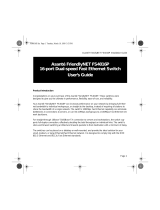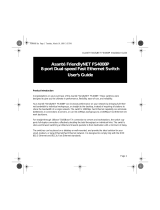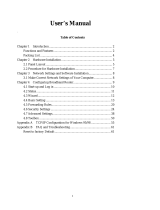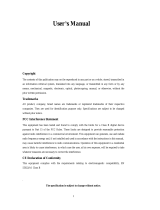Page is loading ...

FriendlyNET
®
VR2004 Series
VPN Security Routers
User’s Manual

FriendlyNET VPN Security Router
2
Before You Start
Thank you for purchasing the Asanté FriendlyNET VR2004 Series
VPN Security Router. Your router has been designed to provide a
lifetime of trouble-free operation. However, to ensure a smooth in-
stallation, you must have the following items before you begin:
•
Internet connection: Valid ISP account and Cable/DSL mo-
dem with 10BaseT Ethernet port. Peripheral port for back
up dial-up (v.90 or ISDN TA) modem included (Contact
your ISP if you have problems verifying that you have a
working Internet connection)
•
Network connection: Built-in 10/100 Fast Ethernet port or
10/100 Fast Ethernet network adapter for each computer
sharing the Internet connection
•
Cables: 10BaseT or 100BaseTX Fast Ethernet cables to
connect computers to the router
•
Client operating system: Client must be capable of accept-
ing an IP address from a DHCP server. Supported operat-
ing systems include Apple Mac OS 9 and higher, Microsoft
Windows 98/ME/2000/XP Home or Professional, Red Hat
Linux
•
Network protocol: TCP/IP network protocol for each client
•
Web browser: Microsoft Internet Explorer or Netscape
Communicator, version 4.0 or later, or Apple Safari
The following devices are not compatible with the VR2004 Series
routers: Cable/DSL modems with USB or Firewire connections,
asymmetrical dual media connections, Home PNA or other non-
Ethernet compatible communication devices.

User’s Manual
3
Quick Start Guide
This section will guide you through setting up the Asanté
FriendlyNET router with your Cable/DSL modem. Setting up your
router requires three basic steps:
1. Determine the TCP/IP settings for your computer and record
them in the table provided.
2. Set up your hardware. You MUST power up the router FIRST
after attaching any devices to the router.
3. Configure your router.
1. Determine Your TCP/IP Settings
You should already have a working Internet connection using a Ca-
ble/DSL modem. First you must collect the TCP/IP settings from
your computer and your Internet Service Provider (ISP). This infor-
mation will be used to configure your new router and any additional
computers you wish to add to your new network. The following sec-
tions explain how to collect your TCP/IP settings for Macintosh,
Windows, and Linux platforms.
Mac OS 9
1. Open your computer’s TCP/IP control panel found under the
Apple menu.
2. For Connect via, verify that either Ethernet built-in or the
Ethernet adapter installed in your Mac is chosen.
3. Complete the information in the Your Settings portion of the
table below.

FriendlyNET VPN Security Router
4
4. Once the information has been recorded, choose Using DHCP
Server from the Configure: pull-down menu. Close the dialog
box and save your changes.
Repeat steps 1, 2, and 4 to configure additional Macs you wish to
add to the router.
Mac OS X
1. Go to System Preferences on your desktop and select Net-
work. In the Network screen that appears, select Show: Active
Network Ports and click the box to choose the PCI Ethernet
card slot where your network card is installed.
2. Click the Apply Now button. The next screen will show the op-
tions for your network settings. Be sure that the TCP/IP tab is
selected.
3. Before changing your configuration, complete the information in
the Your Settings portion of the table below, and save for fu-
ture reference.
Item No. TCP/IP Control Panel Description Your Setting
1 Configure Manually or
Using DHCP Server
Static IP Address or
Dynamic IP Address
2 IP Address WAN IP Address
3 Subnet Mask WAN Subnet Mask
4 Router Address WAN Gateway
5 Name Server Address Primary and Secondary
DNS
6 Host Name (DHCP Server
Only)
Client ID No.

User’s Manual
5
4. Once the information has been recorded, select Configure:
Using DHCP. You will receive an IP address automatically
from your DHCP server.
The TCP/IP configuration of your computer is now complete. Re-
peat steps 1, 2 and 4 to configure additional Macs that you wish to
add to the router.
Windows 98/Me
1. From the Windows Start button, choose Run. In the dialog box,
type winipcfg and click OK.
2. Choose your computer’s Ethernet adapter from the first drop-
down list.
Tip: The PPP setting is usually for your dial-up analog modem.
Don’t choose this selection.
Item No. TCP/IP Control Panel Description Your Setting
1 Configure Manually or
Using DHCP Server
Static IP Address or
Dynamic IP Address
2 IP Address WAN IP Address
3 Subnet Mask WAN Subnet Mask
4 Router Address WAN Gateway
5 Name Server Address Primary and Secon-
dary DNS
6 Host Name (DHCP
Server Only)
Client ID No.

FriendlyNET VPN Security Router
6
3. Expand this dialog box by clicking on the More Info >> button.
4. Complete the information in this table:
Tip: Next to the DNS Servers field, click the button to show the
Secondary DNS (if available).
5. From the Windows Start button, choose Settings and select
Control Panel. Double-click the Network icon.
6. In the Configuration tab, highlight the TCP/IP protocol line as-
sociated with your network card adapter.
7. Click Properties to open the TCP/IP Properties dialog. Click the
IP Address tab. Select Obtain an IP address automatically.
Click OK.
8. Click OK again. Windows will begin copying files to your com-
puter. Click Yes to restart your computer with the new settings.
Repeat steps 1-3 and 5-8 to configure additional PCs on your net-
work.
Note: Keep your Windows CD handy. You may be asked to insert it
so that Windows can copy necessary files.
Windows NT/2000
1. From the Windows Start button, choose Run. In the dialog box,
type command and click OK.
2. At the command line, type the command ipconfig /all and
press Enter.
3. Fill in the table below with the data from the screen.
Item No. IP Configuration Description Your Setting
1 Host Name Host Name
2 DNS Servers Primary DNS
3 Secondary
4 Adapter Address MAC Address
5 IP Address WAN IP Address
6 Subnet Mask WAN Subnet Mask
7 Default Gateway WAN Gateway

User’s Manual
7
Windows XP
1. From the Start button, select Settings/Control Panel.
2. Click on Network and Internet Connections.
3. Click the Network Connections icon.
4. Double-click on the network.
5. Under the Support tab, click on the Details… button.
6. Record your information on the table below for future reference.
7. Under the General tab, click the Properties button.
8. Select the Internet Protocol (TCP/IP) and click the Properties
button.
9. Select Obtain an IP Address automatically and Obtain DNS
server address automatically.
10. Click OK. You will be prompted to restart your computer.
Item No. IP Configuration Description Your Setting
1 Host Name Host Name
2 Primary DNS Primary DNS
3 Physical Address MAC Address
4 IP Address WAN IP Address
5 Subnet Mask WAN Subnet Mask
6 Default Gateway WAN Gateway
Item No. IP Configuration Description Your Setting
1 Physical Address MAC Address
2 IP Address WAN IP Address
3 Subnet Mask WAN Subnet Mask
4 Default Gateway WAN Gateway
5 DNS Servers Primary
Secondary
6 WINS Servers Primary
Secondary

FriendlyNET VPN Security Router
8
The TCP/IP configuration of your computer is now complete. Re-
peat steps 1 – 4 and 7 – 10 to configure additional PCs on your net-
work.
Red Hat Linux
In order to gather the information necessary to complete the table,
you will need to run the /sbin/ipconfig command. You will also
need to examine the following files:
•
/etc/sysconfig/network
•
/etc/resolv.conf.
Please refer to your Linux documentation for information on access-
ing these files.
2. Install The Hardware
Follow these steps to connect the router to your network:
1. Turn the power off to your computers, modem and the router.
2. Connect an Ethernet cable from your Cable/DSL modem to the
router’s WAN port.
3. Connect an Ethernet cable from your computer’s Ethernet port
to one of the LAN ports on the router. Repeat the process to
connect other computers to the router. If you have more com-
puters to add than you have router ports, simply add a hub or
switch to one of the router ports. This creates additional avail-
able ports.
4. Optional: Use a DB-9 to DB-25 serial cable to connect a
straight through modem cable from your external backup mo-
dem to the router’s COM port.
5. Turn on the power to the router FIRST, and let it power up. The
router will enter a self-test mode where the status light will blink
for a few seconds and then stop. The router is ready for opera-
tion. Now you may turn on the power to the devices that are
attached to the router.

User’s Manual
9
3. Configure Your Router
From your computer, use your browser to configure the router for
your network.
1. Start your web browser. Type http://192.168.123.254 into your
browser’s address or location field and press Enter.
2. In a few moments you’ll see the Login screen for the router.
Enter the default username, admin (the default password is
blank), and click OK.
3. Click the Setup Wizard button from the top of the page.
4. Step through the configuration screens along the left side of the
Setup Wizard page.
5. Enter the required values for the WAN type you will use.
6. Be sure to save your configuration and restart the router from
the Save & Restart page in the Setup Wizard.
The basic configuration of your Asanté router is now complete. See
Chapters 2, 3 and 4 for more details.
Note: By default, the password for the router is blank. We strongly
recommend that you assign a password to your router. See page 35
for more details.

FriendlyNET VPN Security Router
10

User’s Manual
11
Table of Contents
Before You Start 2
Quick Start Guide 3
Chapter 1. Introduction 13
Chapter 2. Configuration 17
Chapter 3. Advanced Settings 27
Chapter 4. VPN Configuration 41
Appendix A. Warranty Statement and FriendlyCare
Support 51
Appendix B. FCC Statement 53
Appendix C. Troubleshooting 55
Appendix D. Renewing Client IP Addresses 59
Appendix E. Service Ports 61
Appendix F. Hardware and Software Compatibility 63
Appendix G. Specifications 65
Appendix H. Configuring a System Log Server 69
Appendix I. Your 802.11b Wireless Network 73

FriendlyNET VPN Security Router
12

User’s Manual
13
Chapter 1. Introduction
Thank you for purchasing the FriendlyNET VR2004 Series VPN Se-
curity Router. The router provides an easy, affordable way to com-
municate over the Internet, while ensuring a secure connection to
another VR2004 (or other compatible VPN solution). Whenever
data is intended for the remote site, the router automatically en-
crypts the data and sends it to the remote site over the Internet,
where it is automatically decrypted and forwarded to the intended
destination.
The FriendlyNET VR2004 is available in two configurations:
•
VR2004C: Router with 4-port 10/100 LAN ports and
backup modem port
•
VR2004AC: Router with 4-port 10/100 LAN ports and
backup modem port, plus integrated 802.11b wireless ac-
cess point
1.1 Features
Key features of the router include:
•
Cable/DSL Modem Support: The router is compatible
with all major brands of Cable/DSL modem
•
Asynchronous Port: A dial-up modem (not included) can
be attached to the router to automatically provide a backup
connection should the Cable/DSL connection fail
•
DHCP Server: Automatically assigns IP information to net-
work users
•
DHCP Client: Automatically gets IP information from the
ISP DHCP server
•
Firewall Protection: Built-in NAT firewall provides network
security
•
IP Sharing: Supports unrestricted Internet access for each
network user at all times

FriendlyNET VPN Security Router
14
•
Hacker Attack Logging: Supports general hacker attack
pattern monitoring and logging
•
High Performance 32-bit RISC CPU Engine: With the
most advanced 32-bit RISC CPU engine, the router has
full compatibility with present and future Cable/DSL tech-
nologies
•
PPPoE Client: Supports PPPoE client function to connect
to the remote PPPoE server
•
Virtual Server: Allows an internal server to be accessible
from the Internet
•
Upgradeable: Allows new features to be added in the fu-
ture
•
VPN Support: Supports L2TP pass-through function
•
IPSec Security:
◊
Authentication (MD5 / SHA-1)
◊
DES/3DES Encryption, IP Encapsulating Security
Payload (ESP)
◊
Internet Security Association and Key Management
Protocol
◊
Internet IP Security Domain of Interpretation for
ISAKMP
◊
The NULL Encryption Algorithm and its use with IP-
Sec
◊
8 IPSec Tunnels
◊
IPSec LAN to LAN
◊
IPSec Client to LAN
•
PPTP Support: Support PPTP (Point-to-Point Tunneling
Protocol) function
•
Idle Timer: Lets you set a specified idle-time before auto-
matically disconnecting
•
Routing Protocol: Supports static route, RIP versions 1
and 2
•
Dial-on Demand: Eliminates the need for manual Dial-up
and automatically logs in to your ISP
•
Web-Based Configuration: Configure your router from
any standard web browser

User’s Manual
15
•
DMZ (Demilitarized Zone): Allows you to place one server
or workstation outside the firewall, to allow outside parties
unrestricted access to the server
1.2 Package Contents
Please compare the items included in your package to the list be-
low. The following items should be included:
•
FriendlyNET VR2004 Series VPN Security Router
•
Power adapter
•
User’s Manual (this document)
If any of the above items are damaged or missing, please contact
your dealer immediately.
1.3 System Requirements
Before installing the router, you will have need to have met the fol-
lowing requirements:
•
Microsoft I.E 4.0 or later version, Netscape Navigator 4.0
or later version, or Apple Safari
•
One computer with an built in or installed 10 Mbps, 100
Mbps or 10/100 Mbps Ethernet port
•
Optional: One Analog Modem or ISDN TA (if a dialup con-
nection is needed)
•
One RJ-45 Cable/DSL Internet connection
•
TCP/IP protocol installed
•
UTP network cable (Category 5 or better) with a RJ-45
connection
1.4 Front and Rear Panel Descriptions
The front panel of the router contains the LED Indicators for easy
monitoring and troubleshooting of its functioning.
Consult the table below for a description of the LED Indicators.

FriendlyNET VPN Security Router
16
From left to right, the rear panel of the router
contains the following:
Power (5 VDC) plug; Internet (WAN) port; COM port; Reset button;
and LAN ports 4, 3, 2 and 1.
LED Color Description
Link/Activity
LAN ports 1 to 4
Green
Blinking
Off
A valid link has been established on
the port.
Port is transmitting or receiving pack-
ets.
No link has been established on the
port.
Wireless
(VR2004AC model
only)
Green
Blinking Green
A wireless connection has been es-
tablished.
A wireless connection has not been
established.
COM Green
Off
A valid link has been established.
No link has been established.
Internet Green
Off
A valid link has been established.
No link has been established.
Status Blinking Yellow
Off
The router is booting up, or a firmware
upgrade is taking place.
The router is operating normally.
Power Red
Off
The power is on.
The power is off.
Table 1-1 LED Description

User’s Manual
17
Chapter 2. Configuration
Power up the router first,
before powering up the at-
tached devices. Launch
your web browser and type
the default IP address
(192.168.123.254) in the
browser’s address box.
Press Enter. The login window will appear. Type the default user-
name admin and press OK. By default, the password for the router
is blank. We strongly recommend that you assign a password to
your router. See page 35 for more details.
The main menu will appear (screens shown are from both models—
the Wireless Settings page will not appear in screenshots from the
VR2004C model). Click on the buttons across the top to access the
available configuration pages. Within each page, click on the but-
tons along the left side to access further pages for configuration
(see the sections that follow for more details).
2.1 Setup Wizard
From the main menu, click on the corresponding button to access
the Setup Wizard screen. From this screen, it is possible to config-
ure the following:

FriendlyNET VPN Security Router
18
•
Time Zone Settings
•
Device IP Settings
•
ISP Settings
•
Additional ISP Settings
•
Modem Settings
•
VPN Settings
Important! You must save and restart the router in the Save & Re-
start screen for your configurations to take effect.
2.1.1 Time Zone Settings
From the drop down menu, choose the local time zone. Click Next
to enter the data and to proceed to Device IP Settings.
2.1.2 Device IP Settings
To prevent unauthorized access to the router, you should change
the device’s default IP address on your network. This is the internal
LAN IP Address, and NOT the WAN IP Address from your ISP.
Click Next to enter the new values and to proceed to ISP Settings.
2.1.3 ISP Settings
If your ISP requires that you use a static IP Address, check the
Static IP radio button to enable it. If you enable the Static IP Ad-
dress, you must then complete the fields with the information pro-
vided by your ISP (use the information that you recorded in the

User’s Manual
19
Quick Start Guide), and click Next to enter the data. If you use a
dynamic IP Address, check the Dynamic IP radio button and click
Next to continue to Additional ISP Settings.
2.1.4 Additional ISP Settings
In this page, you can enable the type of WAN connection you are
using. Your ISP may require you to use any of PPPoE, PPTP or
AT&T-like authentication.

FriendlyNET VPN Security Router
20
ISPs use the information for authentication purposes, so you must
select the check box and enter the requested information for your
WAN type.
Some providers require the Ethernet address (the MAC address) of
the computer that is connecting the Cable/DSL modem to authenti-
cate the connection. If you are connecting the router to the modem
instead, you must select the check box for Device MAC Address
and enter the WAN MAC address of the router (found in the Device
Status and Device Information pages).
Note: Do not enter the colons between the numbers, as the fields
are already separated within the page.
Note: If you have a single computer attached to the Cable/DSL mo-
dem, you may also use your computer’s network adapter card MAC
Address to allow access to the Internet. Find your card’s MAC Ad-
dress from Windows 98/Me by running winipcfg, or from Windows
2000/NT by running ipconfig /all. To find a Macintosh's Ethernet
MAC address, select "Get Info” from the File menu of either the
AppleTalk or TCP/IP Control Panel. Again, do not enter the colons
that appear within the MAC address, as the fields are already sepa-
rated within the page.
Item Description
User Name Account name (assigned by your ISP).
Password Password for the account (assigned by your ISP).
Idle Time Router attempts to keep the connection on (“keep alive”)
until it has reached a specified idle time; enter a 0 to dis-
able the keep alive feature. Some services will disconnect
the modem when it has exceeded a maximum session time
Enable PPTP Client If you have a PPTP connection, check this box to enable
PPTP client.
My IP Address The IP address provided to you by your ISP
Server IP Address The IP address of the PPTP server provided by your ISP
Connection ID/Name Optional (Enter the connection ID if your ISP requires it)
PPPoE/PPTP Connection
/











